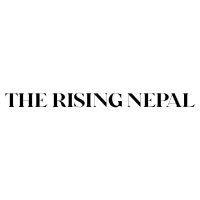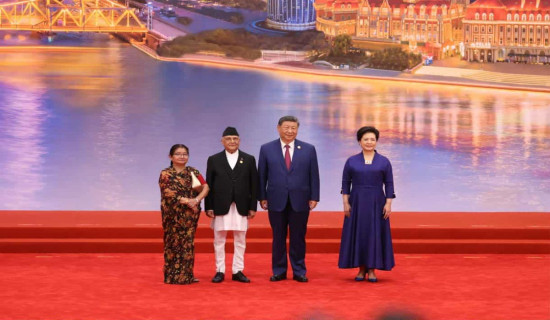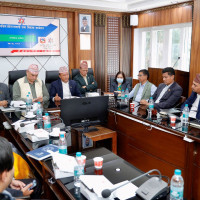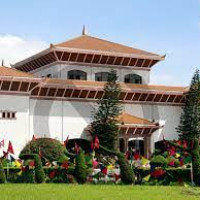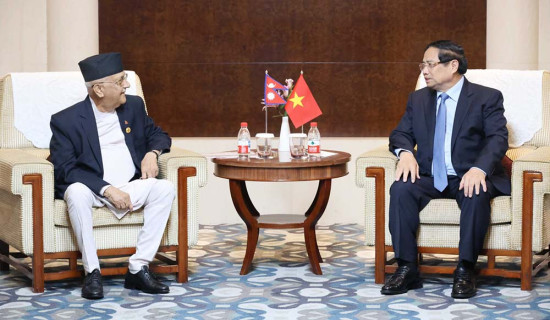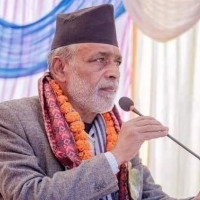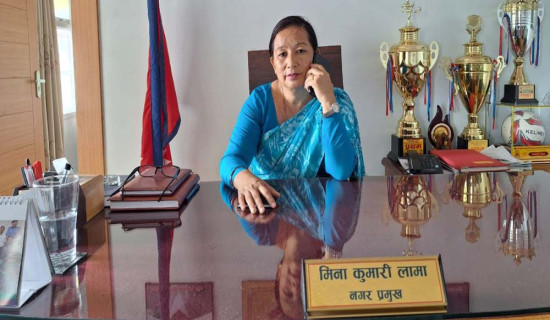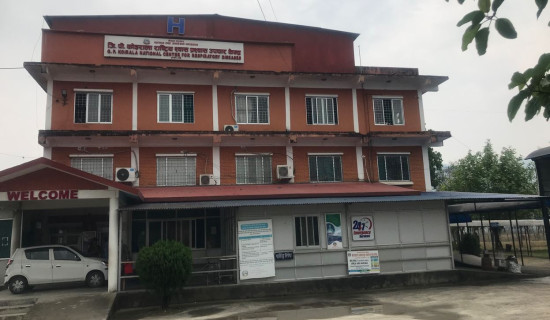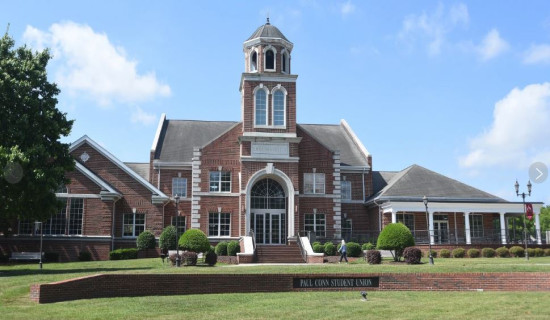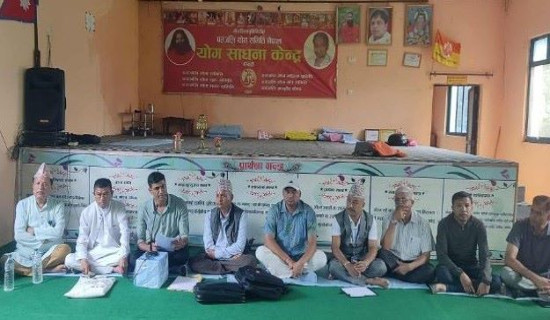- Sunday, 31 August 2025
Public schools par excellence
Raman Paudel,Kathmandu, Aug. 31: We often hear a common question: Which school does your kid go to? An obvious answer we receive ‘…English Boarding School.’ It’s obvious that most parents want to send their children to private schools.
In other words, public schools have been struggling to achieve positive results every year. For this reason, the majority of parents don’t want their children to study in public schools.
Despite many public schools facing a crisis of existence, some are setting an example that attracts a huge number of students.
Kalika Manabgyan Secondary School, located in Butwal, is undoubtedly the largest in terms of student intake across the country. Currently, there are 7,942 students enrolled at this school from grades 1 to 12. With 794 new admissions at grade 11, the school achieved the highest national record this year.
“The only reason many students and parents love our school is our warm relationship with students and guardians. We coordinate with students and parents before making any decision. We take feedback from students before implementing any new plans,” said Dinesh Thapa, Principal of Kalika School.
According to Principal Thapa, the school offers free scholarships to students from poor families. Currently, 43 students are benefitting from the free hostel and study facilities under this plan, said Thapa.
The managerial part as well as the warm relationship between teachers, students, and guardians are the key factors behind its success.
This year, 4,000 new students had applied for admission to this school. Out of the 650 selected new students, 600 came from various private schools.
Six students from Kalika School achieved a 4 GPA and 300 students achieved over 3.6 GPA in the SEE examination this year alone.
Sukuna Ma. Vi. located in Morang district, also serves as an example in school education. Established in 2029 BS, this school has enrolled over 5,000 students.
For this reason, Sukuna School has been recorded as the largest school in the Koshi Province and the eighth across the country. According to Hikmat Kumar Basnet, Principal, this school has been receiving students from all the districts of Koshi Province.
Principal Basnet says, “Our school is undoubtedly the first choice in the Koshi Province. Usually, a student tries to get admission to our school first. He/She goes to other private schools only after being unable to get an admission in our school.”
Principal Basnet said that Sukuna Ma. Vi. has become a model school by using modern technology, an IT-based teaching method, dedicated teachers, smart classrooms, and systematic management.
Teaching in both Nepali and English language, the school has also applied TLIP in its teaching method. All students have an auto-scanner ID card, a high-standard laboratory, tech-based classrooms, and several types of extra activities at the school, said Principal Basnet.
Sukuna School has been offering scholarships to students from financially disadvantaged families. At least 45 students are currently beneficiaries of the scheme.
According to Principal Basnet, the school has also followed internal evaluation and has set a personal record system. The school has also been regularly conducting internal tests targeting weak students.
Furthermore, more than 90 per cent of the teachers at Sukun Ma. Vi. have been teaching their kids at the same school.
Bishwo Niketan School, located in Tripureshwor in Kathmandu, is also one of the popular and crowded public schools. Getting a new admission to this school is considered quite difficult, in terms of tough entrance competition.
Even ministers or political leaders make a phone call to school officials to request for admission, said a teacher from this school.
Heramba Kandel, Principal of this school, said that no one is a ‘boss’ at this school. “We are all equal here.”
Gyanodaya Secondary School, located at Bafal, Kathmandu, is also a model school with more than 4,000 students. According to teachers, every year hundreds of new students are willing to get admission at this school, quitting different private schools. This year, 251 new students were enrolled at the school after quitting various private schools.
Teachers’ dedication to their profession and the management system are key factors that have maintained the school’s exemplary position for a long time.
According to Principal Kandel, Bishwo Niketan has been offering full scholarships or sponsorships to 80 students with the help of various organizations.
Similarly, most of the teachers and administrators have been sending their children to this school.
Meanwhile, modern technology and innovative pedagogy have been applied at this school. Principal Kandel said that they conduct five examinations and hold four meetings with guardians each year. And also the teachers are non-aligned as a political cadre, said Principal Kandel.
Gyanodaya Higher Secondary School, situated in Banke, is another public school that has set an example. Currently, at least 2,108 students are studying at this school.
Trijudda Mahabir Raghubir Ram Ma. Vi., Birta, in Rautahat district, Bagishwari Ma. Vi. Taulachhe in Bhaktapur district, Janata Ma. Vi. in Jhapa district, Durga Laxmi Namuna Ma. Vi., Attariya in Kailali district, Nepal Aadarsha Ma. Vi., Shibapur in Kapilvastu district, Dhulabari Ma. Vi., Dhulabari in Jhapa district, Janata Ma. Vi., Katahariya in Rautahat district, Pokhariya Ma. Vi. in Morang district, Kanti Ma. Vi., Butwal in Rupandehi district, Amar Singh Ma. Vi. in Pokhara, and Tarun Ma. Vi. Balaju in Kathmandu are also popular choices for most students.
What makes some public schools stand out?
According to principals and guardians, common features of these schools are strong management, teachers’ dedication to their profession, coordination between teachers, students, and guardians, use of modern technology in teaching, and use of innovative learning methods.
“Our teachers consider teaching as a profession, not a job. Teaching itself is a service. None of our teachers has compromised their dedication to their profession while teaching,” said Basnet, Principal of Sukuna School.
Another key factor is the political non-alignment of teachers. Heramba Kandel, Principal of Bishwo Niketan School, said that teachers are politically independent. No teacher is an active member of a political party at their school.
Dinesh Thapa, Principal of Kalika School, Butwal, added that they take consent from students and guardians for every decision.
How to upgrade weak public schools?
Despite the good position of some model schools, most public schools are still struggling to upgrade to an average standard. Thousands of public schools fail to achieve good results every year.
Bal Chandra Luitel, education expert and a professor of Kathmandu University, said that public schools require reliable resources, strong management, and well-trained teachers.
Indicating some schools are performing well, Luitel also suggested that the government should accord priority to improve public schools. “Some public schools are performing very well. It’s because of their own effort. The condition of the others is below average. The government should prioritize them,” said Luitel.
As per the economic survey report for the fiscal year 2024/25, there are at least 35,000 public schools across the country. However, around 60 per cent of those schools have less than 100 because of various reasons.
Education expert Luitel suggested that such schools should thoroughly change and improve their management system. “The good results that these schools have achieved have only been possible due to their strong management and willpower,” Dhungana added.
Way to improve further
Though some public schools from all provinces have shown a positive sign, they suffer from a lack of inclusivity in the selection process. Instead, these model schools have been conducting entrance examinations to select new students.
These methods in the selection process might discourage extremely poor and marginalized communities and create discrimination at a psychological level, experts say.
Similarly, the annual and coaching fees have been instituted by schools. These schools also have been conducting classes in two different languages, English and Nepali.
After the multiparty system was established in 1991, the government rapidly set up public schools in every district across the country. However, access to school education for Women, Dalits, and other marginalized communities was restricted for decades.
Some experts argue that the political changes, even after 1991, did not bring any fundamental alterations in the idea of school education, as the curriculum and textbooks were a continuation of the Panchayat era.
Not only the Panchayat period, but also the schools that flourished in the democratic period failed to produce critical thinkers. And this phenomenon continues still today, experts argue.
According to experts, only scoring high grades couldn’t be considered a parameter of learning. Instead, the schools should produce critical thinkers.
Teeka Bhattarai, a senior public educator, suggested that every school needs full support and care from its community. He also argued that such public schools have been weakened only after they have been detached from the community.
“Let’s see such exemplary public schools. They did well with a strong connection with guardians and their local community. How they achieved good results is the guardians’ support,” Bhattrai said, “regarding thousands of other public schools, every community should show ownership.”
Expert Bhattarai also argued that the government can only upgrade the public schools after making communities responsible. At the initial phase, public schools were empowered, while they were run by the community. However, the government nationalized the schools, and the community detached from them, Bhattarai argued.
He also suggested that public schools require regular collection of fees from the guardians. “Those guardians who are financially able need to pay the fees regularly. I know, it sounds negative, but every guardian would be responsible for the future of his/her school,” Bhattarai added.
A similar example, as Bhattarai suggested, is Durbar High School, Nepal’s first school, which has several programmes implemented by Kathmandu Metropolitan City in recent times. Some remarkable programmes implemented by the Metropolis in the last few years, hopefully, will revive the first and historical school.


